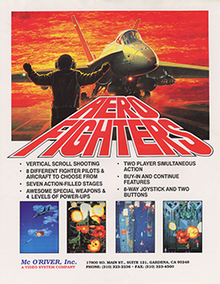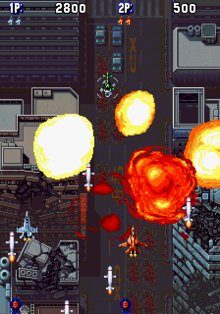Aero Fighters
| Aero Fighters | |
|---|---|
 Arcade flyer | |
| Developer(s) | Video System |
| Publisher(s) |
|
| Designer(s) | Shin Nakamura |
| Composer(s) | Naoki Itamura |
| Platform(s) | Arcade, Super NES |
| Release | |
| Genre(s) | Scrolling shooter |
| Mode(s) | Single player, 2 player co-op |
Aero Fighters, known as Sonic Wings (ソニックウィングス, Sonikku Wingusu) in Japan, is a vertically scrolling shooter originally released in arcades in 1992 by Video System and was ported to the Super Nintendo Entertainment System in 1993. It was the first in the Aero Fighters series, and a spiritual successor to the 1991 Turbo Force.
Gameplay
[edit]
This section needs additional citations for verification. (November 2022) |
This game uses basic shooter mechanics of the SHMUP genre of video games. Pressing button 1 fires normal weapons; this can be upgraded by collecting P or the rare F items, though the maximum power level has a hidden ammo count, after which the player will return to the previous power level. Pressing button 2 launches a powerful special attack; uses are limited to how many B items the player has collected (every life starts with two). Some ground enemies will drop score items when destroyed; they appear as the currency of the selected character's nation. By default, players start with three lives, and can acquire one more at 200,000 points.
Aero Fighters is famous for its large cast of characters, unheard of in 1992. Each pair of characters represents one of four nations.[1] The two-player sides may only select the four characters given (one for each nation).[2] In a two-player game, only a single nation can be chosen.
| Country | Player 1 | Player 2 |
|---|---|---|
| United States | Blaster Keaton (Boeing F/A-18 Hornet) | Keith Bishop (Grumman F-14 Tomcat) |
| Japan | Hien (Mitsubishi FSX) | Mao Mao (Mitsubishi F-15 Eagle) |
| Sweden | Kohful The Viking (Saab AJ-37 Viggen) | Tee-Bee 10 (Saab JAS 39 Gripen) |
| United Kingdom | Villiam Syd Pride (McDonnell Douglas AV-8 Harrier II) | Lord River N. White (Panavia Tornado IDS) |
The game has seven stages divided into two parts.[1] The first three stages are selected randomly from a group of four, with one for each character's nation; however, a character will never go to its nation's stage. The other four stages are fixed. After beating all seven stages, the player sees the character's ending, then play much more difficult versions of those stages, after which the game truly ends.
In the Super Nintendo version, a special code can be used to play with the spaceship from Rabio Lepus.[3]
Reception
[edit]This section needs expansion. You can help by adding to it. (September 2013) |
In Japan, Game Machine listed Aero Fighters on their May 1, 1992 issue as being the second most-successful table arcade unit of the month.[4] RePlay also reported the game to be the second most-popular arcade game at the time.[5] Despite being a solid entry, the arcade version had little to distinguish itself from the competition. One critic wrote: "Aero Fighters is a thoroughly solid game, let's get that out of the way. It is also a game that is easy to forget. At a time when shooters were a dime a dozen it didn't exactly stand out."[6]
GamePro gave the Super NES version a negative review, saying the weapons are imaginative but the game suffers from slowdown, mediocre graphics, weak sound effects, and "monotonous" music, concluding that "Aero Fighters' action won't stay with you - it's a temporary thrill that eventually retreats to the hanger."[7]
Legacy
[edit]An emulated version of the game was released in 2005 for the PlayStation 2 as part of the Japan-exclusive Oretachi Gēsen Zoku series. In 2022, the original arcade version was included as part of the Sega Astro City Mini V, a vertically-oriented variant of the Sega Astro City mini console.[8] Copies of the game are rare, with astronomical prices on auction sites.[9] In December 2023, the game was later released for the Nintendo Switch and PlayStation 4 as part of the Arcade Archives series.
Sequels
[edit]Shin Nakamura, the main designer of Aero Fighters and a number of other Video System games, disliked the company's plan to start developing on the Neo Geo. He wanted to make more vertical games like Aero Fighters, but found it difficult to do so on a horizontal monitor. He and other like-minded employees left to found Psikyo, with the similar Samurai Aces being their first game.
McO'River would never publish another title under that name. Back at Video System, meanwhile, other employees teamed up with the remaining Aero Fighters staff to begin work on sequels. Aero Fighters 2 and Aero Fighters 3 were released for the Neo Geo. Sonic Wings Special, a sort of "dream match" game based on the three previous entries, was released for the Sega Saturn and later for the PlayStation. Soon after, Special was reworked for the arcades into Sonic Wings Limited. In 1997, McO'River, Inc. changed its name to Video System U.S.A., Inc.[10] A year later, Paradigm Entertainment developed Aero Fighters Assault for Video System. Sonic Wings Special and Limited were both made for a vertical monitor like the first game. Similarly, Nakamura would make Strikers 1945 Plus for the Neo Geo a few years later.
In popular culture
[edit]YouTuber and author John Green, having come across the game in the Savannah Airport, mistakenly read the title as "Nerd Fighters" while filming a video addressing his brother Hank Green on the popular YouTube channel Vlogbrothers on February 17, 2007.[11] "Nerdfighters" and "Nerdfighteria" eventually became the collective title of the Vlogbrothers' fan community.[12] In September 2013, he was given an Aero Fighters arcade cabinet as a gift.[13]
References
[edit]- ^ a b Aero Fighters (1993) (McO'River) (SNS-AERE-USA). 1993.
- ^ "Sonic Wings, Arcade Video game by Video System (1992)". www.arcade-history.com. Retrieved 2022-11-28.
- ^ Consoles + (27 ed.). France. December 1993. p. 119.
{{cite book}}: CS1 maint: location missing publisher (link) - ^ "Game Machine's Best Hit Games 25 - テーブル型TVゲーム機 (Table Videos)" (PDF). Game Machine (in Japanese). No. 425. Amusement Press, Inc. 1 May 1992. p. 25. Archived (PDF) from the original on 2020-01-31. Retrieved 2025-01-17.
- ^ "The Player's Choice - Top Games Now in Operation, Based on Earnings-Opinion Poll of Operators: Best Video Software". RePlay. Vol. 17, no. 10. RePlay Publishing, Inc. July 1992. p. 4.
- ^ lordmrw (2020-03-27). "Aero Fighters review". Classic-Games.net. Retrieved 2022-11-28.
- ^ "ProReview: Aero Fighters". GamePro. No. 61. IDG. August 1994. p. 60.
- ^ McFerran, Damien (December 17, 2021). "Sega's Astro City Mini Is Getting A 'TATE' Version Packed With Shmup Goodness". Nintendo Life. Nlife Media. Retrieved 2021-12-17.
- ^ "The 10 Best SNES Shmups | Blog of Games". 2021-07-20. Retrieved 2022-11-28.
- ^ IGN staff (August 6, 1997). "Mc O'River Renames Itself". IGN. Retrieved 2010-02-04.
- ^ Braun, Eric (2015). John Green: Star Author, Vlogbrother, and Nerdfighter - Gateway Biographies. Lerner Publications. pp. 23, 24. ISBN 978-1467772617. Retrieved 26 March 2016.
- ^ Dean, Michelle (March 13, 2013). "A Note on Nerdfighters". The New Yorker. Advance Publications. Retrieved October 25, 2014.
- ^ Green, John. "Secrets of the Movies: Thoughts from The Fault in Our Stars Set". YouTube.
External links
[edit]- Official website
- Aero Fighters at MobyGames
- Aero Fighters at Arcade-History
- 1992 video games
- Arcade Archives games
- Arcade video games
- Hamster Corporation franchises
- Vertically scrolling shooters
- Super Nintendo Entertainment System games
- Video games developed in Japan
- Video games scored by Naoki Itamura
- Video System games
- Multiplayer and single-player video games
- Tecmo games
- Video games featuring female protagonists
